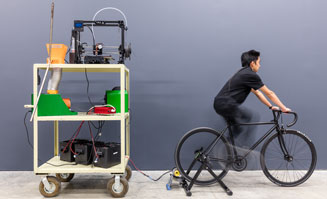Pedal Power uses bicycle to recycle waste

Tucked into an inconspicuous space in one of UC Irvine’s arts buildings is a potential game-changer: a why-didn’t-I-think-of-that model that its creators hope will redefine environmental awareness and help reduce the world’s surfeit of plastic waste.
The ambitious prototype is the brainchild of six very determined undergraduate students from different disciplines who worked together day and night for a year to create it, and their faculty mentor, an engineer-turned-architect-turned-artist.
Calling themselves S.P.A.M. (Specialists in Plastic Additive Manufacturing), the students are fine-tuning a mobile, bicycle-powered, closed-loop 3-D printer station that recycles its own waste.
It works like this: up to three riders pedal bicycles to power the cart-mounted operation; the system sends the energy to a generator, then to a battery, which stores it, and finally to an inverter. There, the DC power is converted into AC, which drives the 3-D printer. If the batteries are completely drained, it takes about an hour of moderate cycling by three riders to generate enough power to start the system. Additional pedaling will keep it running.
In addition to its human-powered energy stream, though, this system earns its environmental bona fides by recycling previously printed products. It grinds them into fragments, melts the plastic and extrudes it back into 3-millimeter plastic filament, spooling it to print the next job.
The project was conceived during last year’s U.S. Department of Energy Solar Decathlon. UCI environmental engineering undergraduates Will Amos and Aldrin Lupisan – who met in their dorm freshman year – were on Team Orange County in the national competition to design and build energy-efficient houses. They were charged with designing a “Tool Room of the Future,” which included a 3-D printer, for the team’s house.
“During the Solar Decathlon, we talked often about this concept [but] we didn’t have the proper time or resources to actually put the idea into action,” Amos says.
Mechanical engineering undergraduate Amihan Amargo also was on Team Orange County, where she met Amos and Lupisan. Unbeknownst to the three budding engineers, Jesse Colin Jackson, a UCI arts professor with an undergraduate degree in civil engineering and expertise in additive manufacturing, was on the contest’s faculty steering committee. Jackson was in possession of newly available lab space, and after meeting the undergrads, offered them a home for their project.
Then he introduced the engineering students to three like-minded arts students − Tina Chau, Aaron Hilado and Eunji Russ − and helped the new group obtain support from UCI’s Undergraduate Research Opportunities Program and Calit2 Multidisciplinary Design Program (MDP).
“I had an existing research agenda in additive manufacturing, and the group wanted to put an additive manufacturing room in the Solar Decathlon house, so it evolved from there,” Jackson says. “These students are not my graduate students; they didn’t enroll to be part of the lab. It’s a collective of people with common interests who want to tackle projects together.”
A few members of last year’s S.P.A.M. team graduated this year, but several new members are signing on, and the group will continue its quest for sustainability. Its ultimate goal: recycling all of the lab’s waste material. “It’s a work in progress,” says Jackson.
Amos, Lupisan and their new recruits will spend another school year honing the innovative system. Anticipated updates include the addition of wind and solar power, a feedback system to provide stats on how much power is being generated and synching the extractor and spooler to keep the system humming along efficiently.
Team members say MDP, with its multidisciplinary emphasis, is a plus. “I’ve never really worked with engineers before,” says artist Chau. “What one person lacks, the other makes up for. It was a really interesting experience to see how everyone’s grown and changed for the better.”
Amargo majored in mechanical engineering and minored in digital art. “Art students and engineering students do things differently so it’s nice to have different approaches.”
S.P.A.M.’s efforts are reverberating well beyond UCI. The project is featured in “The 3D Additivist Cookbook,” an e-book available later this year. Additionally, members have hauled the cart to area high schools, a TEDx event and other venues to share its message of environmental responsibility. “We have reached a milestone… a place where it works well enough to be able to describe what we’ve done, but we’d like to engineer it to work better on a practical level, which is quite a few more additional steps,” says Amos, who was named one of six national winners of the 2016 Brower Youth Awards recognizing outstanding young leaders in the environmental movement.
For Jackson, the goal involves more than the next upgrade, cautioning that research goes beyond problem-solving. “Solving suggests that you’re done, and none of these projects is ever done,” Jackson says. “It’s about asking new questions – we’re more interested in asking new questions than we are in arriving at solutions.”